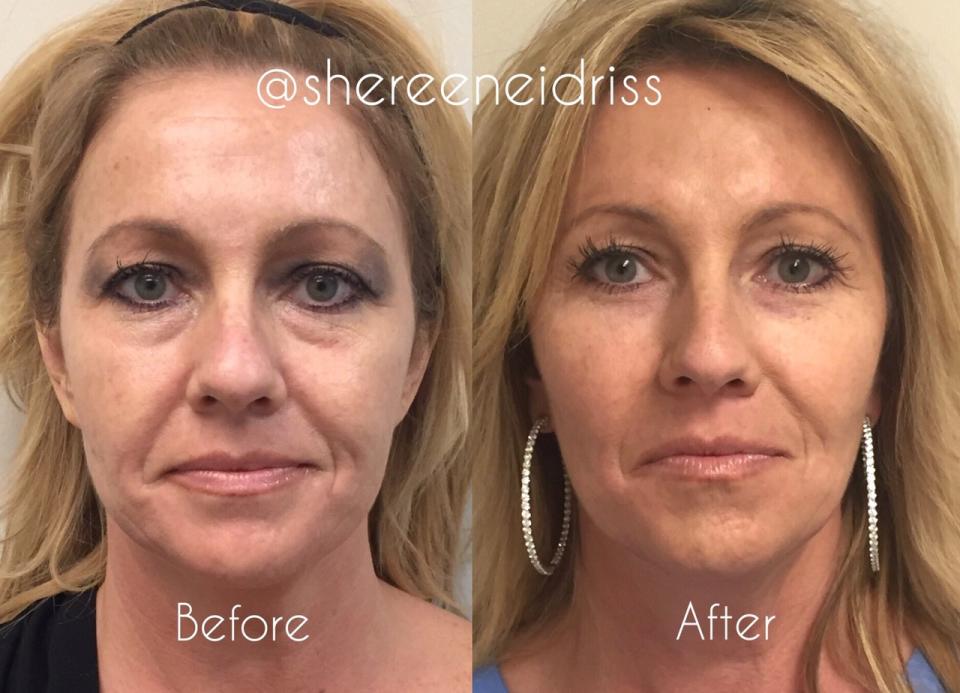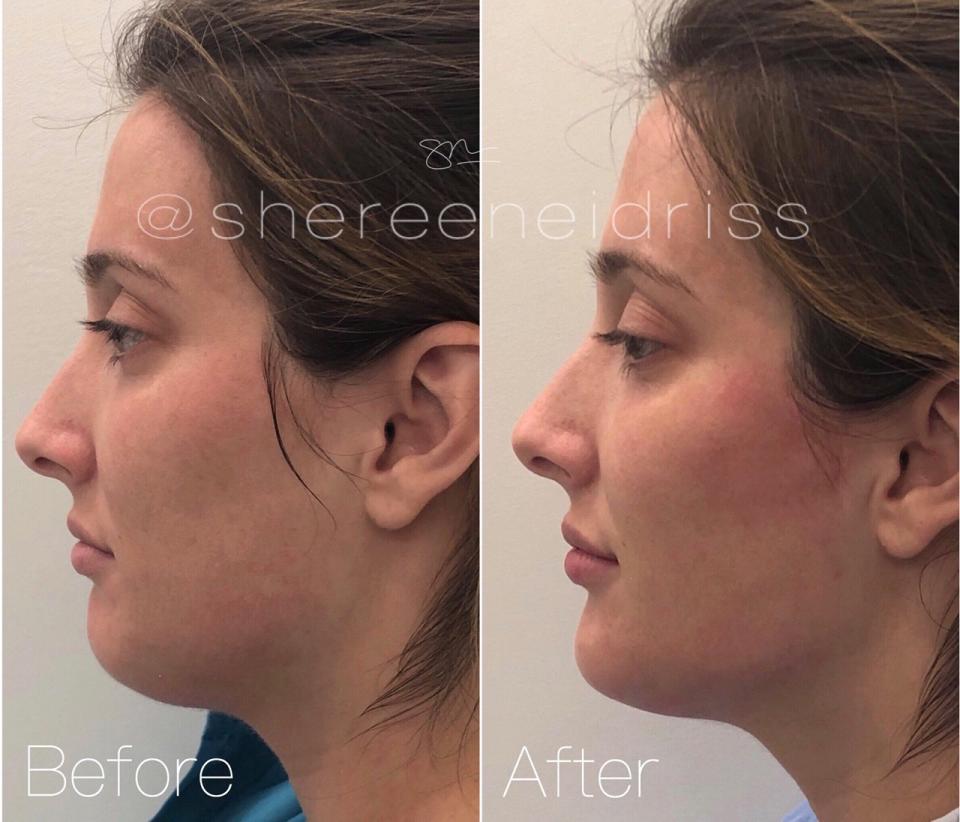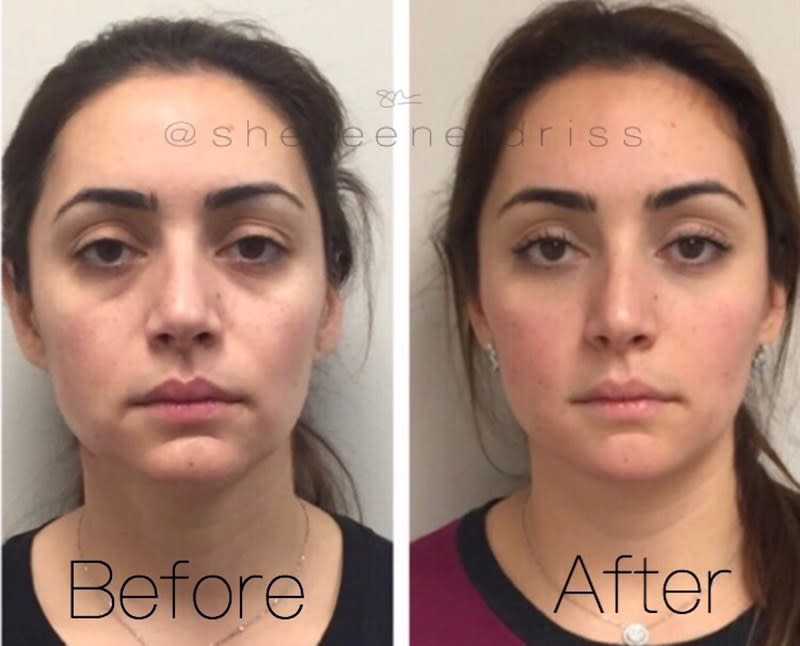The Complete Guide to Facial Fillers
Interest in plastic surgery is at an all-time high, but stigma and misinformation still surround the industry and its patients. Welcome to Life in Plastic, a series by Allure that aims to break down cosmetic procedures and provide all the information you'll need to make whatever decision is right for your body — no judgment, just the facts. Here, we're covering everything you need to know about fillers.
We hear it from experts every day: Cosmetic injections are not akin to haircuts, and shouldn't be approached with the same it'll-grow-back attitude, since having prescription drugs and medical devices — as neurotoxins and fillers, respectively, are classified by the Food and Drug Administration — shot into one's face can carry consequences far graver than a botched bang trim. But doctors' anti-cavalierism crusade is constantly being bucked. In Los Angeles, for instance, the hair analogy is being spun as a win by an injectables outpost dubbed the "Drybar of Botox," which offers hyaluronic acid (HA) fillers (like Restylane and Juvéderm), neurotoxins (Botox and Dysport), and fat-melting Kybella with a breezy-as-a-blowout, nothing-to-fear vibe.
Injectables are big business: Over two million people received botulinum toxin or filler injections in 2017, according to the American Society for Aesthetic Plastic Surgery. The popularity of temporary HA fillers, specifically, has soared 85 percent since 2012. And practitioners of all kinds — with varying degrees of training and experience — are capitalizing on the demand.
Consequently, doctors are seeing a dramatic rise in both complications (from fillers, in particular) and plain, old bad work. Beyond fixing her daily share of filler-related lumps and asymmetries incurred by other injectors, New York City dermatologist Shereene Idriss has more and more "patients coming in looking like caricatures of themselves — with disproportionately large lips and flattened nasolabial folds — due to misplaced filler injected by untrained practitioners," she says.
And while some fillers can be dissolved with a quick shot, not all mistakes are so effortlessly undone. "With every kind of filler, there's the risk of unintentional injection into a blood vessel, which can result in skin death, scabbing, scarring, even blindness," Idriss adds.
That said, fillers are generally very safe when injected by board-certified dermatologists and plastic surgeons armed with an intimate knowledge of human anatomy and "filler crash carts" stocked for potential complications. (Shoutout to New York City plastic surgeon Lara Devgan for sharing that gem of a term.) But this is merely rule number one of getting filler. Read on for everything experts want you to know before submitting to the syringe.
Not all fillers are created equal.
While the lion's share of fillers in your dermatologist's armamentarium are made of HA — a safe sugar found naturally in the human body — a few are made from other materials. Radiesse contains the mineral calcium hydroxylapatite (the stuff of teeth and bones, it's visible in X-rays and CT scans). Sculptra uses poly-L-lactic acid (PLLA), a biodegradable man-made polymer — the same component in absorbable stitches. Bellafill suspends polymethylmethacrylate (PMMA), or nonbiodegradable acrylic beads, in cow-derived collagen, and "is essentially permanent," says New York City plastic surgeon Paul Lorenc.
Unlike HA fillers, which basically serve as place holders — substitutes for depleted collagen and fat — these others are known as biostimulatory fillers: They give an immediate, short-term plumping "due to the simple fact that liquid is being injected into the face," says Idriss, but their primary purpose is to spark the growth of your own collagen for longer-lasting fullness and lift. (By stimulating fibroblasts, HAs have also been shown to "ramp up collagen and elastin production over time," though likely to a lesser extent, says Laurel Geraghty, a dermatologist in Medford, OR.)
Despite their chemical similarities, the HA gang is actually a very diverse group. These 14 gels vary in density, viscosity (or flow), elasticity, lift-ability (or stiffness, what docs call "G prime"), and longevity — traits that shape their personalities and determine their role among fillers. Robust, buoyant fillers like Restylane Lyft and Juvéderm Voluma can help sculpt and define a jawline, or restore volume and projection to the cheeks while hiking the lower face; whereas light, slippery, malleable HAs, like Juvéderm Volbella and Belotero Balance, are a better fit for, say, the barcode-like lines striating the delicate upper lip.
Depending on how a formula's molecules are strung together, some HAs will break down faster, or swell up more than others (and while that added oomph may benefit areas like the cheeks, nobody wants puffy under-eyes post-injection). Doctors take all of this into consideration when selecting the right product for you and your features. Which brings us to our next need-to-know….

Life in Plastic: Facial Fillers (1).JPG
Courtesy Shereene IdrissJust because your friend got Voluma, doesn't mean you should.
While it's always prudent to know what's being injected into your body, derms don't love it when you go in requesting a specific filler brand (Juvéderm, Restylane) or subtype (Ultra Plus, Defyne). "I believe in having a frank discussion with patients, and then deciding together what's best," says Miami dermatologist Janelle Vega. "But when patients come in saying, 'My friend had Voluma in her lips, so why don't you do that?,' or 'I read you should never use X in the cheeks' — that truly is an energy drain and takes the focus off of what’s appropriate for that person's needs, goals, and anatomy."
And I have to say, when reporting this story, I asked experts which fillers they like best for distinct areas and concerns, and with a few exceptions, there was little overlap. Some even gave multiple nuanced solutions for various scenarios: "If a patient already has adequate volume in the central lip, but has begun to lose it along the borders, then Restylane-L is my go-to; it has a firm feel and is made for precise, targeted placement," explains Idriss. "On the other hand, if volume is receding from the body of the lips, I'll use soft, smooth Volbella to add subtle fullness." Choose an injector based on his or her education, expertise, and aesthetic — and then refrain from any backseat doctoring.
Lip filler doesn't have to look like...well, lip filler.
Despite all the Klones on IG, lip augmentations can, in fact, look super natural and undetectable. While everyone agrees that only HA should be used in the lips — "it integrates well without causing issues," says Vega — the exact type depends on your individual needs and desires. "Around age 30, everyone's lips start to slowly deflate and lose their shape — but this can look different on everyone," says Los Angeles dermatologist Michael Kassardjian, who prefers taking a conservative approach with lips, commonly reaching for "soft, flexible HAs that spread well and don't look stiff or overdone," he says.
According to Vega, some folks aren't looking for a volume boost at all, but instead more of a "general poutiness and lip-gloss effect." In this case, injection technique and HA placement are as crucial as the type of gel a doc selects.
Savvy derms can even rejuvenate a mouth without injecting directly into the lips: "A tiny drop of filler placed into the Cupid's bow can add structure and support, helping to minimize top-lip wrinkling without risking the dreaded duckbill effect," Geraghty says. (Know before you go: Injecting around the mouth can reactivate the herpes virus. If you have a history of cold sores, ask your MD about taking antiviral pills prior to treatment.)
Fillers can do more than enhance lips and downplay wrinkles.
They can elevate sunken scars; reinflate hands; brighten cavernous under-eyes; and sharpen jaw lines that have gone soft. The doctors we spoke to universally use brawny structural fillers (Radiesse, Juvéderm Ultra, Restylane Lyft) in the hands and jawline. For the transparent under-eye area, injecting a fine layer of a more fluid HA — one that doesn't swell or cast a bluish glow (something known as the Tyndall effect) — "can lift the skin up and away from underlying vessels, obscuring discoloration and hollows," says Kassardjian.
For acne scars, there's currently only one filler technically FDA-approved for the job: Bellafill. "Because it’s acrylic based, it has more lifting power for correcting depressed scars," says Lorenc. Yet, despite its heft and longevity, many dermatologists and plastic surgeons like to address divots with smooth, reversible HAs instead.
"When treating scars, we have to inject superficially," explains Devgan. "So we need to be careful with something non-dissolvable that carries a risk of nodules [lumps], because if you do get a little imperfection, we either have to leave it or surgically remove it — and those aren’t good options."

Life in Plastic: Facial Fillers (2).JPG
Courtesy of Shereene IdrissBut they can't fix absolutely everything.
Filler, on its own, can't counteract significant sagging or disappear deeply etched lines. The tiny grooves scoring the upper lip, for example, typically present with some degree of laxity, says Kassardjian, and may require a pu pu platter of procedures, including filler, Botox, peels, microneedling, and/or laser resurfacing. Same for smile lines: If they're really dug in, filler can't erase them entirely. And while it can hoist slack skin to some extent, don't expect a face-lift.
They're not for absolutely everyone.
Fillers are off the table for pregnant and breastfeeding moms, along with anyone fighting active infections, and folks who are allergic to filler constituents. (Some come premixed with the anesthetic lidocaine; tell your doc if you're allergic, so he can avoid them. Since Bellafill contains bovine collagen, a pre-shot skin test is generally required.)
Radiesse shouldn't be used in those with severe allergies or bleeding disorders, notes Geraghty. "Patients who are immunocompromised, or have a history of autoimmune disease, may also need to avoid fillers," says Kassardjian. And if you're prone to keloids, have your injector test a small, discreet area before poking around your face.
Yes, injections hurt — some areas more than others.
Regardless of the filler within, "a needle to the face is a needle to the face," says Idriss. Some gels do contain lidocaine, but in our experience, they still smart. Topical numbing creams, ice packs, vibrational tools, and now ProNox (a self-administered laughing gas) can help lessen — or at least distract from — the sting. Perhaps the most ouchy area of all, "the lips have a ton of nerve endings, so for sensitive patients, I'll often inject lidocaine inside the mouth to temporarily block pain in and around the lips," Geraghty says.
You may look bruised and swollen after.
From purple pinpoints to glaring black eyes, bruises are a super-common side effect of injectables, resulting from the needle grazing or more seriously injuring a blood vessel. To reduce the risk, try not to pop any drugs or supplements that might increase your risk of bleeding in the days before your appointment (these include aspirin, ibuprofen, naproxen, fish oil, ginkgo biloba, and St. John's Wort). You may see some swelling, too — remember: fillers pull in water — but it tends to peak two to four days post-shot and then subside. "Give swelling and bruising at least two weeks to resolve before assessing your results," says Geraghty.
Even tiny tweaks can make a major difference.
If you can't put a finger on any one thing that's irking you, but simply want to look less blah, "tiny drops of filler in strategically placed locations can give an overall refresh," says Kassardjian. Lean on your doctor for ideas, as “she might suggest a tweak you never would've considered — and it could make that perfect, subtle difference," says Geraghty.
Case in point: "People don't come in asking me to inject their temples to fill out the hollows that make their face appear sunken, but they almost universally love it once it's been done," she adds.
Certain spots are considered high risk.
"Every injectable experience is a walk through tiger territory, as any time a needle is in close proximity to a vessel, we think about avoiding intra-arterial injection and tissue death [i.e. filler invading or compressing a vessel, cutting off blood supply, and causing the skin to wither and die]," explains Devgan. "The glabella [between the eyebrows], nose, and under-eyes are especially worrisome because injection into the feeding vessels in those areas can risk blindness."
Some doctors will refuse to treat such danger zones. The lips and nasolabial folds (or smile lines) — two major hotspots for filler — also carry the risk of skin death. But board-certified dermatologists and plastic surgeons are trained to proceed with caution and handle problems that arise.

Life in Plastic: Facial Fillers (2).JPG
Courtesy of Shereene IdrissSome fillers can be dissolved if you don't like the way they look.
Kylie's "I got rid of all my filler" post thrust hyaluronidase into the spotlight, but the enzyme shot can only undo HA-based mistakes. Which is why biostimulatory products, like Radiesse, Sculptra, and Bellafill, "are generally not what I'd call beginner-level fillers — they're more nuanced and much harder to take back," notes Devgan.
While one study published earlier this year found that sodium thiosulfate can be used to dissolve Radiesse, it's not yet common practice, as "additional studies are needed to assess the optimal timing and dosing," says Idriss.
Don't count on filler to last as long as advertised.
HA fillers will last anywhere from a few months to up to two years. (Since biostimulatory ones gradually grow collagen, their effects can last longer, but even they require touch-ups, as the body continuously degrades collagen over time.) How well a particular dose wears depends on the type of filler used, the amount injected, the unique rate at which your body metabolizes it, and where the filler is placed.
"It's thought that areas most subject to motion break down filler faster — so that means cheeks, lips, and smile lines may lose it before under-eyes," says Geraghty. Devgan explains the slow-fade of filler with an ice-cube analogy: "The average ice cube may last for 10 minutes out of the freezer, but after five minutes, it's halfway melted," she says. "And an ice cube in the desert isn't going to last as long as an ice cube in Alaska. If you handle and crush the ice, it'll melt even faster. So when we say a filler lasts up to two years, that doesn't mean it's going to look exactly perfect, like the day we injected it, two years from now — there's significant change over time."
If you're considering facial fillers, seek out a board-certified plastic surgeon for an initial consultation.
For more plastic surgery trends:
Now watch as a dermatologist explains lip injections:
Follow Allure on Instagram and Twitter, and subscribe to our newsletter for daily beauty stories delivered right to your inbox.

